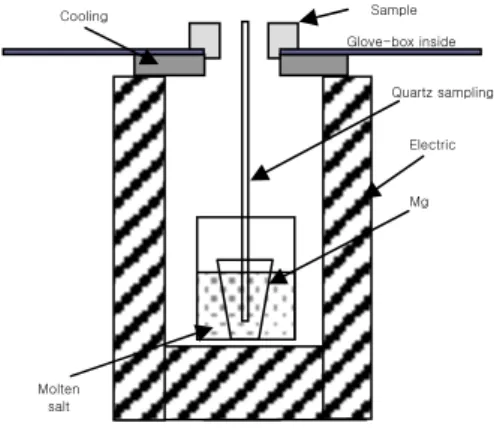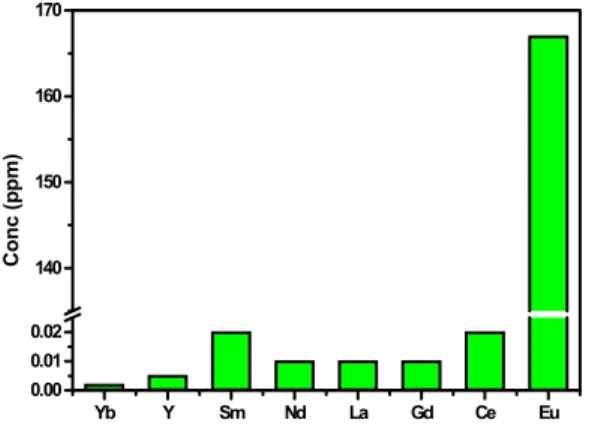Solubility of various lanthanide oxides in LiCl-KCl eutectic melt at 723K.
Tack-Jin Kim *, Young-Hwan Cho, In-Kyu Choi, Kwang-Soon Choi and Kwang-Yong JeeKorea Atomic Energy Research Institute,150 Dukjin-Dong Yusong-Gu, Daejeon, 305-353 Korea
*corresponding author: yhcho@kaeri.re.kr
1. Introduction
Molten salt based electrochemical processes have been proposed as a promising method for future nuclear programs.[1-2] One of the important steps in the pyro-processing of spent nuclear fuel is electrorefining in molten LiCl-KCl based media. During the course of theses electrochemical processes, information on the chemical behavior of some lanthanide elements is of great concern in electrorefining step. The knowledge on the basic chemical properties of these metal oxides in molten salt media is essential for developing suitable processes. However, few studies have been reported until now on the chemical and electrochemical behavior of lanthanide oxides in LiCl-KCl melt. So, we studied the solubility, EPR and luminescence of lanthanide oxides.
2. Experimental
All the experiments were carried out in an Ar atomosphere glove box to avoide exposure to oxgen and water. The LiCl-KCl eutectic (41.5 mole% KCl) mixture (melting point 634 K) was prepared from LiCl (Aldich) and KCl (Aldirch). Dried slats were mixed and melted under purified Ar atmosphere. The oxygen and H2O level was maintained to be less than 2 ppm. Figure1 schematically shows the apparatus used for solubility measurements. For this, 1 gram of each lanthanide oxide (Ln2O3 form) powder was added to 100 grams of LiCl-KCl eutectic mixture preheated to 723 K in a glassy carbon crucible. Ln2O3 samples were used after heating the purchased reagents to 923 K for 12 hours to oxidize hydroxide form impurity, if exits.[3] After equilibrating for 10 hours, the molten salt sample was taken using a quartz tube. Magnesium filter was used to prevent lanthanide oxide fine particles being included in molten salt samples for analysis. The concentration of lanthanide element in the sample was determined by ICP-AES. The EPR spectra of the sample in LiCl-KCl matrix were recorded at room temperature on a Bruker EMX spectrometer at X-band frequency. The samples were taken from molten LiCl-KCl eutectic melt and cooled (hereafter referred as molten salt sample otherwise being stated). About 50 mg of each sample was inserted into a quartz tube and sealed to prevent contacting with air. The corrected fluorescence emission and excitation spectra were measured on an Edinburgh FS920 fluorometer with the excitation sources from a 450 W Xe-lamp and
Hamamtsu R955 PMT. Alternatively, the 325 nm line of a He-Cd laser was used for excitation. A Jobin Yvon JY ULTIMA 2C, the combination of sequential and simultaneous types of ICP-AES, was used to measure europium contents. The operation conditions of ICP-AES for the determination of these elements were shown in Table 1. Analyses were done in triplicate using a two-point calibration.
Figure 1. Apparatus for solubility measurement in molten salt.
3. Results and Discussion
The results of solubility measurement are summarized in Figure 2. In general, the oxides of actinide and lanthanide elements are sparingly soluble or insoluble in molten salt. However, as shown in Figure 2 , the solubility of europium oxide appeared to be several orders of magnitude higher than that of other lanthanide oxides in LiCl-KCl eutectic melt at 723 K. This anomalously high solubility of Eu oxides may be attributable to the different chemical behavior of europium under the chemical condition described. In a similar experiment to support Li metal reduction process in LiCl at 973 K, CRIEPI group reported the same solubility trend and the solubility of europium oxide was a little bit higher than our results.[4] Based on EPR and luminescence results, one can safely conclude that europium oxide dissolved in LiCl-KCl eutectic melt at 723 K exists predominantly as Eu2+. However, other lanthanide ions existed as trivalent species in the same conditions. It seems that above described unusal redox behavior of europium oxide in LiCl-KCl eutectic melt are closely related to higher solubility in the same condition. The detailed
Electric Glove-box inside Quartz sampling Molten salt Cooling Sample Mg Transactions of the Korean Nuclear Society Autumn Meeting
mechanism of Eu2O3 reduction to Eu(II) is not yet clearly identified at the present time, requiring more studies. However, EPR and luminescence studies provide detailed information regarding the nature of europium ion in molten salt.
Figure 2. Solubility measurement of lanthanide oxide in LiCl-KCl melt at 723 K.
4. Conclusions
We have studied the solubility of various lanthanide oxides in LiCl-KCl eutectic melt at 723 K. Europium oxides exhibited abnormal behavior in solubility and redox chemistry. The solubility of europium oxide was measured to be ~3 orders of magmitude higher than that of other lanthanide oxides. This abnormal solubility behavior may be attributable to different electrochemical behavior of europium in the same experimental conditions, compared with other REE elements. Europium ion was found to exist predominantly as divalent species in LiCl-KCl melt at 723 K, in contrast to other lanthanide ions favoring trivalent state. The EPR and luminescence studies provide detailed information regarding the nature of europium ion in molten salt.
Acknowledgement
This study was supported by the Mid- and Long-Term Atomic Energy R&D Fund of Korean Ministry of Science and Technology.
REFERENCES
[1] K. R. Seddon, J. Chem. Tech. Biotechnol. 68(1997) 351. [2] D. J. Fray, J. of Metallur. (2001) 26.
[3] H. Hayashi, K. Minato, J. Phys. Chem. of Solids 66 (2005) 422
[4] T. Usami, M. Kurata, R. Yuda, T. Kato, Japan CRIEPI Repot T99088 (2002) Yb Y Sm Nd La Gd Ce Eu 0.00 0.01 0.02 140 150 160 170 Conc ( p pm)

